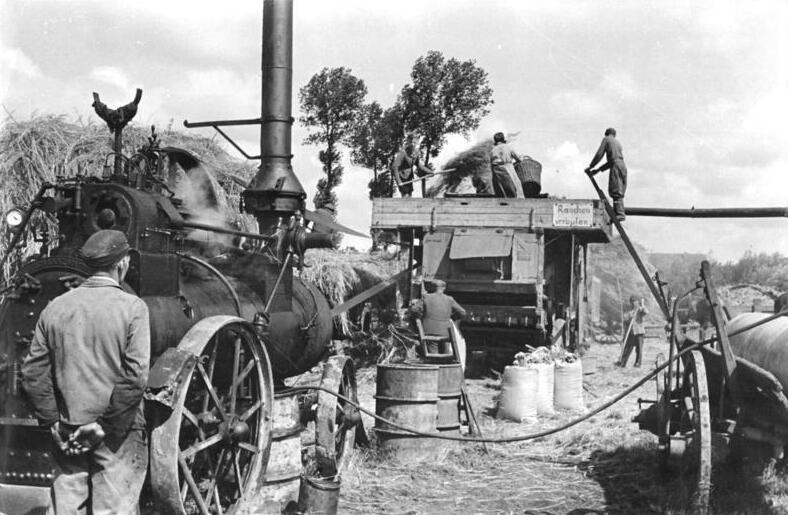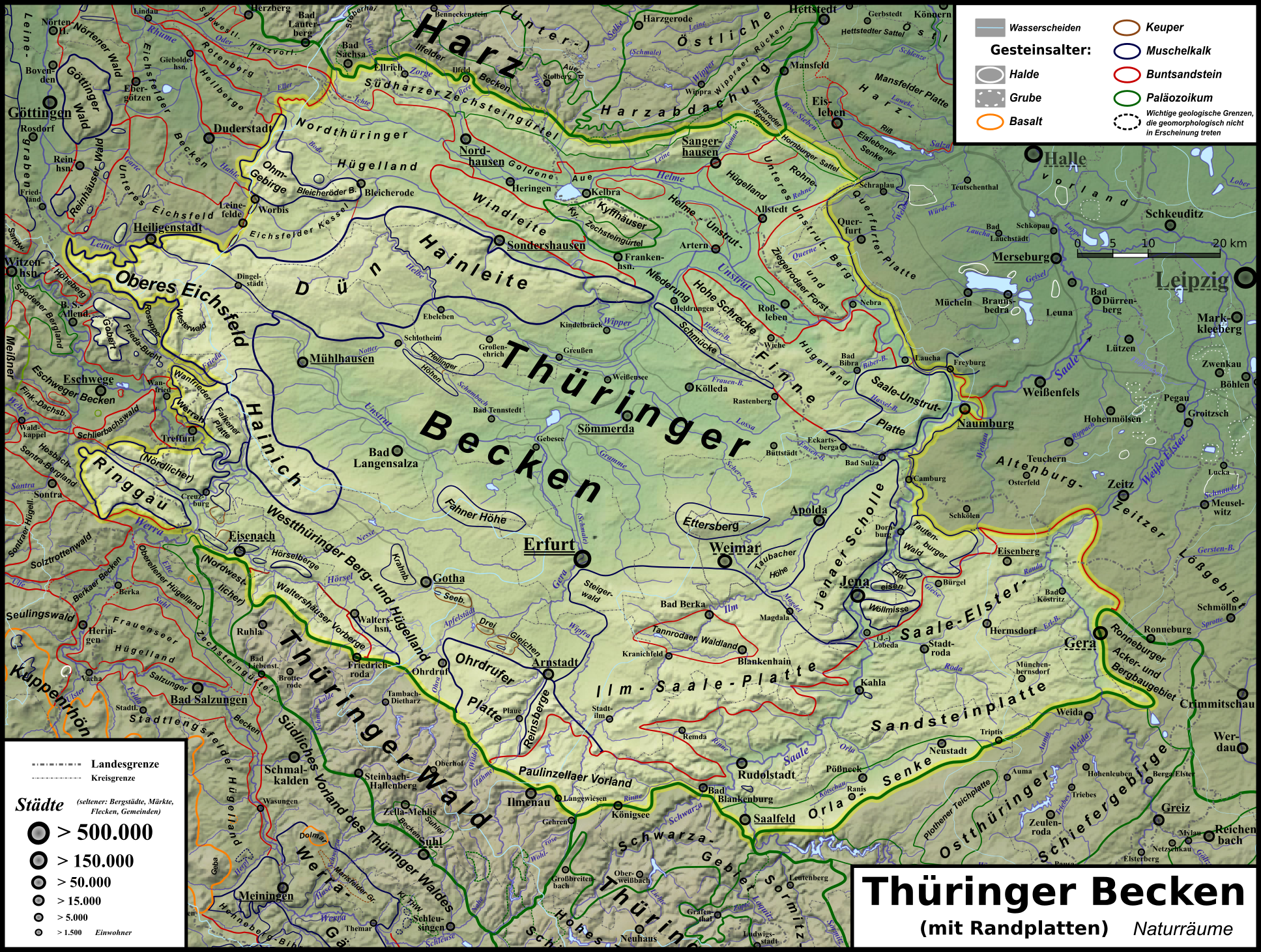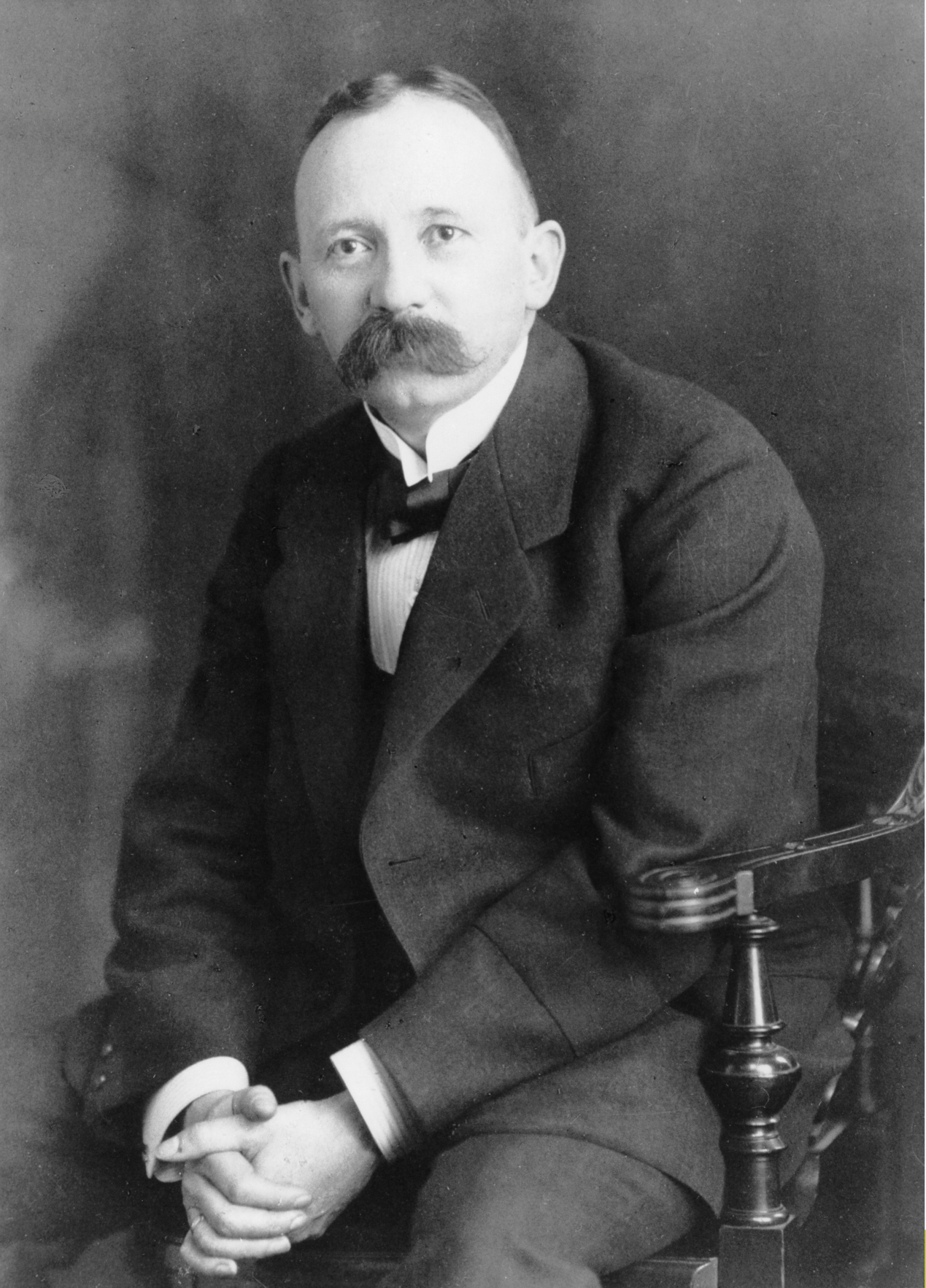|
Kölleda
Kölleda (until 1927 Cölleda) is a small rural town in Thuringia. The municipality belongs to the district of Sömmerda and is located about ten kilometres east of the district town of Sömmerda on the edge of the Thuringian Basin. It is the third largest municipality in the district with about 6300 inhabitants. Kölleda is the seat of the Kölleda administrative community, although it does not belong to it. The inhabitants are called "Kölledaer". Kölleda is a sub-centre for the region. The town is characterised by a former traditionally large cultivation of medicinal and aromatic herbs, especially peppermint. This led to the nickname "peppermint town" and "peppermint railway" for the Straußfurt-Großheringen railway line that runs past. Kölleda has an eventful 1200-year old history. Significant for the town's development during the National Socialist era were the construction of an air base and an aircraft office for the Luftwaffe and later, during the GDR era, the VEB Fu ... [...More Info...] [...Related Items...] OR: [Wikipedia] [Google] [Baidu] |
Sömmerda (district)
Sömmerda (German: ''Landkreis Sömmerda'') is a ''Kreis'' (district) in the north of Thuringia, Germany. Neighboring districts are (from the north clockwise) the districts Kyffhäuserkreis, the Burgenlandkreis in Saxony-Anhalt, the district Weimarer Land and the district-free city Erfurt, and the districts Gotha and Unstrut-Hainich-Kreis. History The district Sömmerda was created in 1952. In 1994, the districts of Thuringia were reorganized, and the district Sömmerda was enlarged significantly by adding municipalities from the dissolved districts Artern and Erfurt-Land. Geography The main river in the district is the Unstrut. The nearby town of Kölleda is known locally as the Peppermint City because of its long history of growing aromatic and medicinal herbs. Coat of arms The coat of arms shows the three historic states which Sömmerda belonged to in the past. In the left is the Saxon symbol, to the right is the lion as symbol of Thuringia, and in the bottom is the Wheel of M ... [...More Info...] [...Related Items...] OR: [Wikipedia] [Google] [Baidu] |
Beichlingen (noble Family)
Beichlingen is a village and a former municipality in the Sömmerda district of Thuringia, Germany. Since 1 January 2019, it is part of the town Kölleda Kölleda (until 1927 Cölleda) is a small rural town in Thuringia. The municipality belongs to the district of Sömmerda and is located about ten kilometres east of the district town of Sömmerda on the edge of the Thuringian Basin. It is the thi .... References Sömmerda (district) Former municipalities in Thuringia {{Sömmerda-geo-stub ... [...More Info...] [...Related Items...] OR: [Wikipedia] [Google] [Baidu] |
Thuringian Basin
The Thuringian Basin (german: Thüringer Becken) is a depression in the central and northwest part of Thuringia in Germany which is crossed by several rivers, the longest of which is the Unstrut. It stretches about from north to south and around from east to west. Its height varies from about 150 to . The Basin is surrounded by a wide outer girdle of limestone (Muschelkalk) ridges (including Hainich, Dün, Hainleite, Hohe Schrecke, Schmücke, Finne), and to the southwest by the Thuringian Forest and to the southeast by sharply divided terraces (the Ilm-Saale and Ohrdruf Muschelkalk plateaus, and the Saale-Elster Bunter sandstone plateau). The Thuringian Basin belongs to the triassic period, during which horizontal beds of Bunter sandstone, Muschelkalk and Keuper were laid down. Below those lie the salt and gypsum layers of Magnesian Limestone (Zechstein). In the Cenozoic era the surrounding ridges were uplifted, whilst the Thuringian Basin sank to form a saucer-shaped depressio ... [...More Info...] [...Related Items...] OR: [Wikipedia] [Google] [Baidu] |
Friedrich Ludwig Jahn
(11August 177815October 1852) was a German gymnastics educator and nationalist whose writing is credited with the founding of the German gymnastics (Turner) movement as well as influencing the German Campaign of 1813, during which a coalition of German states effectively ended the occupation of Napoleon's First French Empire. His admirers know him as , roughly meaning "Father of Gymnastics ". Life was born in the village of in Brandenburg, Prussia. He studied theology and philology from 1796 to 1802 at the universities in , , and . After the Battle of Jena–Auerstedt in 1806, he joined the Prussian army. In 1809, he went to Berlin where he became a teacher at the and at the Plamann School. Brooding upon what he saw as the humiliation of his native land by Napoleon, conceived the idea of restoring the spirits of his countrymen by the development of their physical and moral powers through the practice of gymnastics. The first , or open-air gymnasium, was opened by in in ... [...More Info...] [...Related Items...] OR: [Wikipedia] [Google] [Baidu] |
Fritz Hofmann (chemist)
Fritz Hofmann (Friedrich Carl Albert) (2 November 1866 in Kölleda – 22 October 1956 in Hanover) was a German organic chemist who first synthesized synthetic rubber. Hofmann studied chemistry in Rostock. On September 12, 1909, he filed a patent for the manufacture of the world's first synthetic rubber. Honors *In 1912, Hofmann received the Emil Fischer Hermann Emil Louis Fischer (; 9 October 1852 – 15 July 1919) was a German chemist and 1902 recipient of the Nobel Prize in Chemistry. He discovered the Fischer esterification. He also developed the Fischer projection, a symbolic way of draw ... Medal from the German Chemical Society for his research on synthetic rubber. See also * Sergei Vasiljevich Lebedev References External links * Organic chemists 20th-century German chemists 20th-century German inventors University of Rostock alumni Humboldt University of Berlin alumni Polymer scientists and engineers Commanders Crosses of the Order of Merit of the ... [...More Info...] [...Related Items...] OR: [Wikipedia] [Google] [Baidu] |
Thuringia
Thuringia (; german: Thüringen ), officially the Free State of Thuringia ( ), is a state of central Germany, covering , the sixth smallest of the sixteen German states. It has a population of about 2.1 million. Erfurt is the capital and largest city. Other cities are Jena, Gera and Weimar. Thuringia is bordered by Bavaria, Hesse, Lower Saxony, Saxony-Anhalt, and Saxony. It has been known as "the green heart of Germany" () from the late 19th century due to its broad, dense forest. Most of Thuringia is in the Saale drainage basin, a left-bank tributary of the Elbe. Thuringia is home to the Rennsteig, Germany's best-known hiking trail. Its winter resort of Oberhof makes it a well-equipped winter sports destination – half of Germany's 136 Winter Olympic gold medals had been won by Thuringian athletes as of 2014. Thuringia was favoured by or was the birthplace of three key intellectuals and leaders in the arts: Johann Sebastian Bach, Johann Wolfgang von Goethe, and Fried ... [...More Info...] [...Related Items...] OR: [Wikipedia] [Google] [Baidu] |
Wiehe
Wiehe () is a town and a former municipality in the Kyffhäuserkreis district, in Thuringia, Germany. Since 1 January 2019, it is part of the town Roßleben-Wiehe. It is situated south of Sangerhausen, and north of Weimar. Location Wiehe is located in the valley of the Unstrut on the northern slope of the Hohe Schrecke, a wooded mountain ridge. State roads 1215 and 1217 are the traffic connections to the surrounding area of Saxony-Anhalt and Thuringia. Arms Blazon: “In silver a haloed saint in a blue cloak, in his right hand a raised silver knife, holding a staff in his left hand; at his feet a black shield, inside a golden branch bend with three golden maple leaves." The coat of arms shows St. Bartholomew, the patron saint of the parish church in Wiehe, with his attributes. The shield shows the family coat of arms of the Lords of Werthern, who held lordship initially through resale from 1453 and hereditarily from 1461 in the repeatedly divided Grafschaft Wiehe. The shield ... [...More Info...] [...Related Items...] OR: [Wikipedia] [Google] [Baidu] |
District Town
Town of district significance is an subdivisions of Russia#Administrative divisions, administrative division of a raion, district in a federal subjects of Russia, federal subject of Russia. It is equal in status to a selsoviet or an urban-type settlement#Administrative divisions, urban-type settlement of district significance, but is organized around a types of inhabited localities in Russia, town (as opposed to a rural locality or an urban-type settlement); often with surrounding rural territories. Background Prior to the adoption of the 1993 Constitution of Russia, this type of administrative division was defined on the whole territory of the Russian SFSR as an inhabited locality which serves as a cultural and an industrial center of a district and has a population of at least 12,000, of which at least 80% are workers, public servants, and the members of their families.Иванец Г.И., Калинский И.В., Червонюк В.И. Конституционное прав ... [...More Info...] [...Related Items...] OR: [Wikipedia] [Google] [Baidu] |
Eckartsberga District
Eckartsberga () is a town in the Burgenlandkreis district of Saxony-Anhalt, Germany. It is situated west of Naumburg. It is part of the ''Verbandsgemeinde'' ("collective municipality") An der Finne. Since 2009 it has included the former municipalities of Burgholzhausen and Tromsdorf. People * (1835-1895), violinist and composer *[...More Info...] [...Related Items...] OR: [Wikipedia] [Google] [Baidu] |
Merseburg Administrative District
Merseburg () is a town in central Germany in southern Saxony-Anhalt, situated on the river Saale, and approximately 14 km south of Halle (Saale) and 30 km west of Leipzig. It is the capital of the Saalekreis district. It had a diocese founded by Archbishop Adalbert of Magdeburg. The University of Merseburg is located within the town. Merseburg has around 33,000 inhabitants. Names * cs, Merseburk, Meziboř * french: Mersebourg * german: Merseburg * la, Merseburga * pl, Międzybórz * wen, Mjezybor Geography The town Merseburg consists of Merseburg proper and the following four ''Ortschaften'' or municipal divisions:Hauptsatzung der Stadt Merseburg § 15, April 2019. * |
Province Of Saxony
The Province of Saxony (german: link=no, Provinz Sachsen), also known as Prussian Saxony () was a province of the Kingdom of Prussia and later the Free State of Prussia from 1816 until 1944. Its capital was Magdeburg. It was formed by the merger of various territories ceded or returned to Prussia in 1815 by the Congress of Vienna: most of the former northern territories of the Kingdom of Saxony (the remainder of which became part of Brandenburg or Silesia), the former French Principality of Erfurt, the Duchy of Magdeburg, the Altmark, the Principality of Halberstadt, and some other districts. The province was bounded by the Electorate of Hesse (the province of Hesse-Nassau after 1866), the Kingdom of Hanover (the province of Hanover after 1866) and the Duchy of Brunswick to the west, Hanover (again) to the north, Brandenburg to the north and east, Silesia to the south-east, and the rump kingdom of Saxony and the small Ernestine duchies to the south. Its shape was very irregular ... [...More Info...] [...Related Items...] OR: [Wikipedia] [Google] [Baidu] |
Prussia
Prussia, , Old Prussian: ''Prūsa'' or ''Prūsija'' was a German state on the southeast coast of the Baltic Sea. It formed the German Empire under Prussian rule when it united the German states in 1871. It was ''de facto'' dissolved by an emergency decree transferring powers of the Prussian government to German Chancellor Franz von Papen in 1932 and ''de jure'' by an Allied decree in 1947. For centuries, the House of Hohenzollern ruled Prussia, expanding its size with the Prussian Army. Prussia, with its capital at Königsberg and then, when it became the Kingdom of Prussia in 1701, Berlin, decisively shaped the history of Germany. In 1871, Prussian Minister-President Otto von Bismarck united most German principalities into the German Empire under his leadership, although this was considered to be a "Lesser Germany" because Austria and Switzerland were not included. In November 1918, the monarchies were abolished and the nobility lost its political power during the Ger ... [...More Info...] [...Related Items...] OR: [Wikipedia] [Google] [Baidu] |





_-_1875.jpg)
